Shipwreck Conservation Centre
The Shipwreck Conservation Centre is a branch of the National Maritime Museum in Gdańsk, opened in 2016 in a specially designed building in Tczew, near the Vistula River Museum.
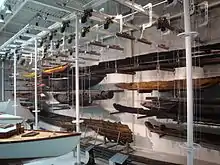 | |
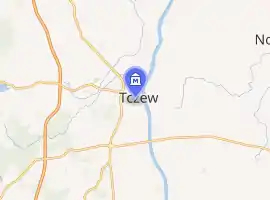
| |
| Established | 2016 |
|---|---|
| Location | Tczew, Poland |
| Coordinates | 54.084804°N 18.794965°E |
| Director | Bogusław Sobkowicz |
| Website | Shipwreck Conservation Centre |
The museum consists of two main parts: the conservation workshop and the studio warehouse, which complement each other.[1]
Funding
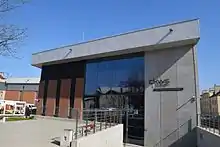
The Centre was opened thanks to a collaboration with the Norwegian Maritime Museum in Oslo and the Museum of Cultural History, Oslo. It was funded by the EEA and Norway Grants (85%) and the Polish Ministry of Culture and National Heritage (15%).[2] The aim of the grant was to make maritime heritage accessible to young people and future generations.[3]
Conservation workshop
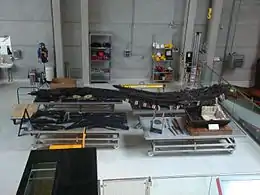
The workshop is fitted with modern equipment and is used to conduct the conservation and reconstruction of recovered fragments of ships and other objects. The workshop is divided into smaller work areas including a steel workshop, a boat building and carpentry workshop; RTG and scanning equipment and a spectrometer used for examining the composition of metal fragments.
Wood recovered from underwater by archeologists is conserved in a special tank system, where it can be immersed in special solutions. Cleaning objects made of metal is accomplished using specialised cleaner machines. Heavy elements are moved with a gantry crane capable of lifting up to 5 tons.[4]
The workshop is a large warehouse, without inner walls. The mezzanine allows visitors to see the restoration works in progress and observe each stage of conservation and reconstruction.[5]
Studio warehouse
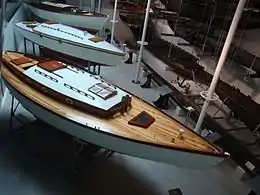
The studio warehouse serves as a large exhibition space. Along one of the walls, historical boats and boat fragments are hung. The boats originate from Poland (the oldest presented boats were built in the 5th and 7th centuries AD) and Africa (acquired by Polish ship crews).[6] The exhibition also features a collection of kayaks from the 1930s to 1950s.
The floor area is used to display large ship elements such as the keel and fragment of side of The Copper Ship (Miedziowiec). The exhibition is completed by three historical yachts: Opty (yacht of Leonid Teliga, the first Pole to single-handedly circumnavigate the globe), Dal (on which Andrzej Bohomolec, Jerzy Świechowski and Jan Witkowski were the first Poles to sail across the Atlantic) and Kumka IV – a pioneering construction by Tadeusz Sołtyk, one of the first welded yachts.[6]
Smaller objects (elements of ship equipment and cargo) are placed in the studio warehouse shelving units, where visitors can see them from up close.[6]
Visitor facilities
The Centre conducts educational activities (museum lessons and guided tours of the conservation workshop).
The museum is accessible to people with disabilities. Guided tours for people with impaired vision are offered, including the possibility to explore selected exhibits by touch.
See also
References
- "New Shipwreck Centre set to boost tourism in Tczew | News | Metropolitan Area Gdańsk Gdynia Sopot". en.metropoliagdansk.pl (in Polish). Retrieved 2017-03-29.
- "Shipwreck Conservation Centre in Tczew - Shipwreck Conservation Centre - National Maritime Museum in Gdańsk". www.en.nmm.pl. Retrieved 2016-09-14.
- "Shipwreck Conservation Centre with Studio Warehouse in Tczew -... - EEA Grants". eeagrants.org. Retrieved 2016-09-19.
- "Conservation Workshop - Shipwreck Conservation Centre - National Maritime Museum in Gdańsk". www.en.nmm.pl. Retrieved 2016-09-14.
- Zieliński, Przemysław. "Centrum Konserwacji Wraków Statków w Tczewie już otwarte [WIDEO, ZDJĘCIA]". Retrieved 2016-09-19.
- "Studio Warehouse - Shipwreck Conservation Centre - National Maritime Museum in Gdańsk". www.en.nmm.pl. Retrieved 2016-09-14.
External links
- Official website
- Virtual Open-Air Museum of Wrecks in the Gulf of Gdańsk
- "It preserves the wrecks of ships. Only such Museum in Poland" (in Polish). tvn24. July 2, 2016. Retrieved December 28, 2016.
- "In July, the Shipwreck Conservation Centre opens in Tczew" (in Polish). onet. June 12, 2016. Retrieved December 28, 2016.
- "Shipwreck Conservation Centre in Tczew – New Polish Museum" (in Polish). Sztuka Architektury. January 20, 2016. Retrieved December 28, 2016.